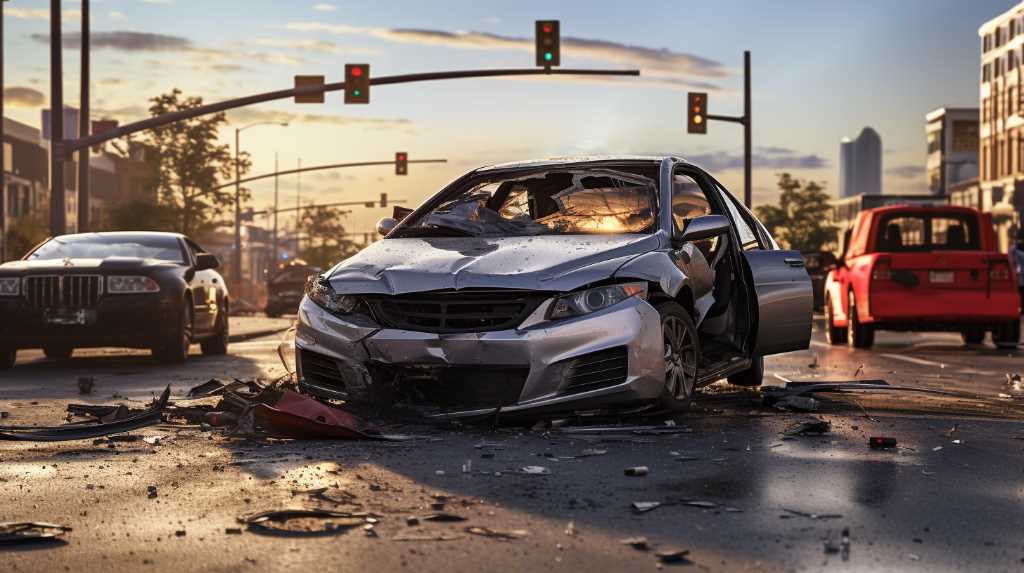
When figuring out who is to blame for a T-bone car crash, it’s really important to look closely at what happened.
A T-bone crash is when one car hits the side of another car, and these usually happen at crossroads. They can be pretty bad.
You have to check if everyone was following traffic lights and rules, and what exactly the drivers were doing before the crash.
It’s also key to look at the accident spot, check out any clues left behind, and hear what any witnesses have to say.
Understanding the road rules well and checking everything carefully helps figure out whose mistake mainly caused the wreck.
Understanding T-Bone Accidents
Liability in a T-bone collision hinges on the critical assessment of the actions leading to the perpendicular impact between two vehicles. This type of accident typically occurs at intersections and is characterized by one vehicle striking the side of another, forming a ‘T’ shape at the point of collision. Determining fault necessitates a meticulous examination of traffic signals, right-of-way laws, and the drivers’ adherence to road safety protocols.
Contributing factors such as speed, distraction, or impairment are methodically scrutinized. Forensic evidence from the accident scene, including skid marks, vehicle damage, and eyewitness testimony, is systematically analyzed to establish a precise sequence of events. The objective is to ascertain which driver acted negligently, thus breaching their duty of care on the road.
Examining Traffic Signals
Looking at how traffic lights work, we can see that they play a big role in figuring out who was at fault in a side-impact car crash. These lights help manage car movement at crossroads by telling drivers when it’s their turn to go. If the lights are working, they make it clear what drivers should do. But if there’s a problem with them, figuring out who’s to blame can get tricky.
Experts need to carefully check what happened, look at the timing of the lights, and use things like what witnesses say and video from traffic cameras to understand the situation. Getting this information right is very important. If a traffic light wasn’t working right, it might show that a driver who was going to be blamed for not waiting their turn is actually not at fault.
This is why it’s so important to look at everything carefully when deciding who caused the crash.
Right-of-Way Considerations
Understanding the right-of-way rules is essential in determining liability in T-bone collisions, as these regulations dictate which vehicle had the priority to proceed at the time of the accident. An analytical examination of the accident scenario must consider all applicable right-of-way laws, including but not limited to, stop signs, yield signs, and uncontrolled intersections.
The driver who failed to yield the right-of-way is typically at fault. However, establishing the precedence of right-of-way is a methodical process; it requires a precise evaluation of the traffic conditions, signage, signals, and the actions of each driver involved.
The principle is clear: a driver entering a roadway must yield to traffic already on the main road, and turning vehicles must yield to oncoming traffic that poses an immediate hazard.
Driver Behaviors and Fault
When figuring out who’s at fault in T-bone car crashes, it’s key to look closely at what each driver was doing. We need to carefully check what happened right before the crash, like if someone didn’t stop at a red light, didn’t give way when they should have, was driving too fast, or made dangerous moves.
It’s also important to see if the driver was distracted, maybe by their phone, or if they were under the influence of alcohol or drugs. Collecting evidence, like videos from traffic cameras, what eyewitnesses say, and how the cars were damaged, helps us figure out the truth.
In the end, we decide who’s at fault by matching up the drivers’ actions with the laws about driving safely and responsibly.
Investigating Accident Scenes
When looking into a T-bone car crash to figure out who is at fault, investigators start by taking note of all the physical clues like tire marks, where the cars ended up, and where they hit each other. They do this to understand how fast the cars were going and in what direction before they crashed. It’s important because it shows what happened during the accident.
They also check all the traffic lights and signs to see if the drivers were following the rules. They talk to people who saw the accident and make sure their stories match the physical evidence. If there’s video from security cameras, they watch it carefully to figure out the order of events. They look at car computer information, like when airbags went off, to support what they find. They look at each clue carefully to figure out the true story of the crash.
For example, if the data shows one car sped up just before the crash, it could suggest that driver was at fault. Investigators use this detailed approach to make sure they understand the crash completely.
Conclusion
To figure out who is to blame in a T-bone car crash, it’s really important to look closely at everything. We need to check if the traffic lights were working right, if the drivers were following the rules about who gets to go first, and how the drivers were acting.
We have to see if they were paying attention, if they were sober, and if the traffic lights were doing their job. Knowing who caused the accident matters a lot because it decides who might have to pay for damages and if anyone can get money for their losses.
So, it’s super important to go over the crash site carefully to make sure the right person is held responsible.